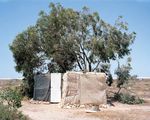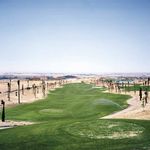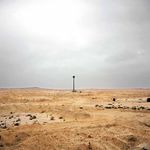Jason Larkin and Corinne Silva: Spaces of Global Capital: On the Photography of Jason Larkin and Corinne Silva - Irene Laub
←
→
Page content transcription
If your browser does not render page correctly, please read the page content below
8 Folio 9
Jason Larkin and Corinne Silva:
Spaces of Global Capital: On the Photography
of Jason Larkin and Corinne Silva
Text by T. J. Demos
The space of global capital—to which Uneven Those barriers create and enforce geographies up against the natural desertscape. Piles
Development, one of the exhibitions comprising of inequality and bear the mark of the ‘uneven of red brick and rebar, mounds of dirt and rock,
the 2012 Brighton Photo Biennial including the developments’ of neoliberalism, keeping the wooden scaffolding, cranes, ladders and pipes
photography of Jason Larkin and Corinne Silva, accumulation of wealth—what the geographer snaking into desert sands appear amidst new
makes reference—is a deeply contradictory David Harvey calls ‘accumulation by road construction and the building of numerous
one. It is filled with tension and conflict at once dispossession’, insofar as private wealth architectural structures, including mosques,
political and socio-economic, architectural and inevitably depletes public resources—from vast apartment blocks and, of course, concrete
geographic. On the one hand, globalisation the growing masses of the impoverished.1 walls and ornate iron gates. Larkin shows
is defined, particularly in the post-Soviet That paradoxical condition of globalisation’s workers in the building sites and security
era after 1989, by the ‘waning’ selectively open and bordered world is, guards protecting the newly created
of national sovereignty with the growing of course, not new—it’s been developing installations, positioned near the freshly
dominance of transnational organisations especially since the late 1970s, with the watered glistening grass of desert golf courses.
like the International Monetary Fund and ascendency of neoliberalism, according He also depicts the drab reality of these
the World Bank, and the rise of multinational to Harvey2—but the extent of its progress installations, next to the sleek billboards
corporations and an increasingly wealthy class is strikingly registered in the photographic advertising the developers’ mirage of a happy
of people—a structural shift that is cause and works of Jason Larkin and Corinne Silva. Their and secure new community set away from
consequence of the mounting flow of money, works focus on the construction of barriers and the slums of the capital (though numerous
resources and people across national borders. the creation of spaces of inequality—what we developers have been jailed for corruption
On the other hand, the space of global capital can call, after Wendy Brown, the contemporary since Egypt’s recent revolution). The geography
is marked by the construction of barriers regime of ‘walling’—in two regions: Southern is thus clearly divided between the haves and
and walls within and between nations, cities, Europe and the Middle East. Take Larkin’s the have-nots. As Larkin’s collaborator journalist
communities and neighbourhoods, built Cairo Divided, a cycle of images from 2011 Jack Shenker writes about this context in Egypt,
ostensibly to stop the passage of criminal that centres on the architectural developments as visualised in Larkin’s photo essay, with some
and terrorist threats, illegal immigration, in peripheral Cairo, an emergent urbanism of degree of sarcasm:3
biological infections, and weapons and drugs. gated communities where built space comes
It’s a process that began long before this
year’s revolution and is continuing well
beyond it, ripping apart old social and
political fabrics and giving birth to a web
of contradictions where the advance
of private capital is marshalled by an
aggressively retreating state, gated
compounds for the elites are reimagined
as inclusive national projects, isolation
gets marketed as community and plush
green golf courses can rise miraculously
from some of the most arid land on earth.
This new age of walling signals the failure
of the modern liberal democratic state, with
its erstwhile commitment to the social welfare
of its citizenry. It is with that commitment
in mind that the foundations of national
commonality, inclusivity and equality once
were built (as initiated by the French Revolution’s
claims for popular sovereignty, continuing
the development of the post-Westphalian
nation-state system). Walling also announces
the breakdown of the post-national claims
Jason Larkin, Cairo Divided, freely distributed newspaper in collaboration with Jack Shenker, 2011.© Jason Larkin Jason Larkin, Untitled #01, from Cairo Divided, 2011. © Jason LarkinJason Larkin, Untitled #22, from Cairo Divided, 2011. © Jason Larkin Jason Larkin, Untitled #24, from Cairo Divided, 2011. © Jason Larkin
Jason Larkin, Untitled #12, from Cairo Divided, 2011. © Jason Larkin Jason Larkin, Untitled #10, from Cairo Divided, 2011. © Jason Larkin
14 Folio 15
that we have entered a post-historical and and blockading in the face of this relegated to the status of noise and invisibility,
borderless ‘new world order’ of globalisation, ungovernability. or working towards the freedom of information
where national boundaries fall and an emergent via the newfound possibilities of digital sharing
era of participation, proximity and openness That breakdown and ungovernability is clear regardless of frontiers (consider the mission
reigns (glimpsed, at least rhetorically, in the in Silva’s Badlands (2011), which pictures of Wikileaks).9 On the other hand, visual
jubilation surrounding the fall of the Berlin the developing frontier territory of Almeria culture, as another space of global capital,
Wall and the formation of the borderless EU, in south-east Spain. The post-Bechers-type clearly continues to be ordered and controlled
as well as in the celebrations of the end of the photo-archive comprises, on the one hand, by powerful media organisations and
apartheid in South Africa at the same time).4 frontal images of resort housing (featuring government elites so that the well-resourced
The emergent ‘new world order’—one of walled concrete structures, walled-in McMansions, have greater access than others to appearance,
states and elite enclosures of wealth, betraying observed from the position of being outside reproduction and dissemination (a fact often
a new post-communitarian era of paranoia and and thus excluded from these islands of overlooked or underplayed by the proponents
xenophobia—is glimpsed in the work of Larkin affluence); and, on the other, plastic and wood of photographic democratisation). As well,
and Silva. shanties built by illegal migrants desperately images, despite new technologies of global
The growth of ‘walled states’, argues seeking opportunity in Europe. Silva’s images distribution like the internet and social media
Wendy Brown, answers anxieties of ‘waning stage a confrontation between the two orders, that facilitate the free sharing of information,
sovereignty’, as spaces of enclosure and security opposing architectural economies and forms are increasingly subjected to a regime of
offer a compensatory image of protection and of life. The one, a post-natural fantasy-based property claims and copyright protections,
security when hitherto unimagined forms manipulation of the landscape-become- where the commodity value of visual forms
of social, political and economic inequality simulacrum (most apparent in the fibreglass is strictly enforced by legal and governmental
struggle to find legitimation within ‘rocks’ built for aesthetic enhancement of the agencies, and marketed by profiting institutions
contemporary governmental discourse, media environment, and the creation of pools and (from galleries to multinational corporations
representations, legal structures and ethical golf courses to make an inhospitable desert such as Bill Gates’s Corbis Images, which charge
codes. Indeed, one sees these developments ecosystem serve the leisure class); the other, large sums for the reproduction of the images
and geographical conflicts worldwide, between an informal architecture of survival, based whose rights they ‘own’).
Israel and Palestine, the US and Mexico, China on an ecology of found and recycled materials The photography of Silva and Larkin
and North Korea, India and Pakistan, as well as and a by-any-means-necessary way of living. challenges both the socio-economic and political
within nations and their various economic and The first exists within the law of consumption, divisions that manifest in the contemporary
social partitions. As Brown writes:5 legal identity and private property; the second, world of walling, and the unequal distribution
an occupation of public property existing of visuality that accompanies it. They do so by
Rather than iterations of nation-state outside the law, in spaces of exception.6 insistently juxtaposing the signs of wealth and
sovereignty, the new nation-state walls Of course, we’ve seen images of migrants’ poverty via the architectural and geographical
|are part of an ad hoc global landscape shanties before (e.g. those of Bruno Serralongue conditions of citizens and migrants, the elite
of flows and barriers both inside nation- in Western France, David Goldblatt in South and the disempowered. The effect is to prompt
states and in the surrounding postnational Africa, Sebastião Salgado in Brazil); but Silva’s critical questioning of these separations and
constellations, flows and barriers that divide series is notable for its juxtaposition that brings to challenge their division, offering viewers
richer from poorer parts of the globe. into view the crisis of economic inequality the visual experience of injustice. As well, they
separated by walled states. ‘This borderland, both make their imagery widely available, both
She continues: where Europe and Africa overlap,’ she writes, on the internet, and experiment with distribution
‘is a microcosm of a rapidly unravelling in the public sphere—in Larkin’s case, in
this [walled] landscape signifies neoliberal fantasy.’7 self-produced freely available newspapers
the ungovernability by [national] law The paradox of waning sovereignty with images, critical essays and descriptions Notes solidarity (such as the trade unions or other social and Sharon Sliwinsky, Human Rights in Camera
and politics of many powers unleashed and walled states—where the latter acts translated into Arabic on Cairo’s real-estate 1 David Harvey, Spaces of Global Capitalism: Toward movements that acquired considerable power in the (Chicago: University of Chicago Press, 2011).
by globalization and late modern as a hyperbolic defence against the former— developments; in Silva’s, in the placement a Theory of Uneven Development (London: Verso, 2006). social democratic state) that put restraints on capital 9 Jacques Rancière, The Politics of Aesthetics, trans.
colonialization, and a resort to policing also finds parallel contradiction within the of images taken in Morocco on billboards 2 David Harvey, A Brief History of Neoliberalism accumulation’ (25–26). Such was witnessed in the police Gabriel Rockhill (London: Continuum, 2004). On
visual conditions of globalisation. On one in Spain, as in her series Imported Landscapes. (Oxford: Oxford University Press, 2005). and military repression of the Occupy movement during Wikileaks, see the conversation between Julian Assange
hand, recent claims for the universality of As such, they make an effort at opposing the 3 Jack Shenker, ‘Cairo Divided: a megacity turns itself 2011, and of the anti-globalisation movement generally and Hans Ulrich Obrist, e-flux 25 (May 2011) at
photographic visuality—whether of artists proprietary claims of image-ownership beyond inside out,’ in the self-published newspaper by Jason since 1999. www.e-flux.com.
or photojournalists—promise newfound the gallery (where they also show their images). Larkin of the same name. He also writes: ‘It is perhaps 5 Wendy Brown, Walled States, Waning Sovereignty
possibilities for citizenship beyond national As such, their work participates in the unsurprising that, in a country which has seen 90% (New York: Zone Books, 2010), p. 24.
borders, as photographic imagery cannot reformulation of the culture of the commons, of its citizens become poorer in real terms since it 6 The ‘state of exception’ designates a spatio-
be controlled or its meaning circumscribed, in opposition to the dystopian future defined signed up to an IMF-led structural adjustment program political regime that divides sovereignty and bare life
and is always open to novel interpretations by the logic of privatisation and walling, which in 1991, the neoliberal transfer of public assets—not just (life stripped of its political identity), a division
and creative uses by unofficial viewers, their images also lay bare. ■ in terms of land, but also of the other environmental increasingly organised according to practices of walling.
oppositional social movements and counter- resources like the water needed to keep the desert See: Giorgio Agamben, State of Exception, trans. Kevin
public spheres.8 In addition, photography green—should be met with such enthusiasm by those Attell (Chicago: University of Chicago Press, 2005).
participates in the proposed ‘redistribution at the apex of finance and government alike.’ 7 See Silva’s website: www.corinnesilva.com/
of the sensible’ in the name of equality, 4 Indeed, as Harvey observes in Spaces of Global badlands.
contesting the order of appearance that divides Capitalism, ‘the neo-liberal state is hostile to (and in some 8 See the recent arguments of Ariella Azoulay, The
those who have a part from those who are instances overtly repressive of) all forms of social Civil Contract of Photography (New York: Zone, 2008),
Corinne Silva, Resort town of Al Hoceima placed in former industrial zone, Cartagena, from Imported Landscapes, 2010. © Corinne Silva Corinne Silva, New suburb of Tangier placed in former mining region La Unión, Murcia, from Imported Landscapes, 2010. © Corinne Silvaabove Corinne Silva, Plastic Mountain I, plastic recycling plant, from Badlands, 2008 - 2011. © Corinne Silva above Corinne Silva, Shaded Settlement I, from Badlands, 2008 - 2011. © Corinne Silva below Corinne Silva, Plastic Mountain II, plastic recycling plant, from Badlands, 2008 - 2011. © Corinne Silva below Corinne Silva, Shaded Settlement III, from Badlands, 2008 - 2011. © Corinne Silva
Corinne Silva, Castle II, from Badlands, 2008 - 2011. © Corinne Silva Corinne Silva, Castle VIII, Badlands, from 2008 - 2011. © Corinne Silva
You can also read



























































